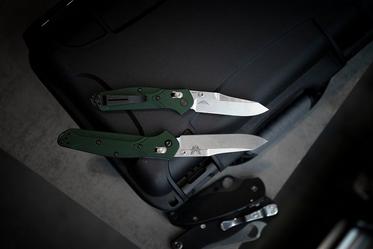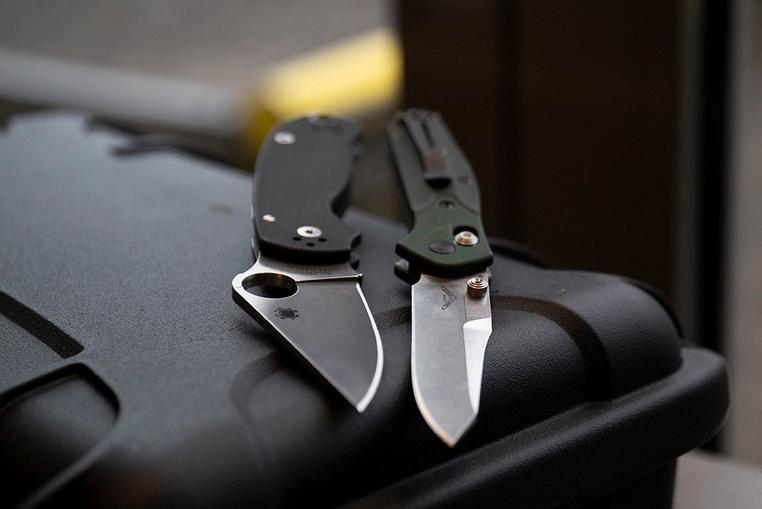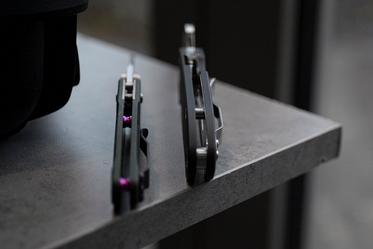Spyderco Para 3 vs Benchmade 945 Mini Osborne
The Spyderco Para 3 and Benchmade 945 Mini Osborne are two amazing EDC knives. Popular amongst enthusiasts for their functionality, appealing design and size. But what are the differences? Are there similarities? We will tell you!
For this versus we compare the Spyderco Para 3 C223GP and the Benchmade 945 Mini Osborne.
The similarities between the Spyderco Para 3 and Benchmade 945 Mini Osborne
The Para 3 and the Mini Osborne are two completely different knives. And yet there are some things they have in common as wel. Both knives, for instance, are a smaller version of a knife that was introduced some time ago. The Para 3 of the Paramilitary 2, and the 945 Mini Osborne of the 940 Osborne. Both knives are produced in the United States, can be opened with one hand and have a blade length of approx. 7.5 cm.
The pocket clips are also similar in terms of function. Both clips aren't deep-carry pocket clips. This means they are located a little higher in your pocket. As such they are also easier to take from your pocket when you need them!
Another similarity is that a larger version exists of both knives. The Paramilitary 2 C81GP2 and the Benchmade 940 Osborne. We also wrote a versus of these knives. Read it here.
The blade
The Spyderco Para 3 is enhanced with a high blade. The Benchmade 945 Mini Osborne is not. As such the knife is a lot slimmer and won't take up too much room in your pocket. The advantage of the high blade of the Para 3 is that you have enough room to place your thumb. The result is that you have more control over the knife as you use it. The finger groove, which is missing from the 945 Mini Osborne, also helps with this.
The grind is also different. The Para 3 is enhanced with a high, completely flat grind and a leaf-style blade shape. The 945 Mini Osborne is enhanced with a low, partially flat grind and a reverse tanto-style blade shape. This high flat grind makes the Para 3 a better slicer when cutting food or cardboard. The blade is namely incredibly thin behind the edge and gradually becomes thicker. Like a kitchen knife. This does mean, however, that the tip is a little more fragile. Because of the grind and the reverse tanto-style tip the blade of the Mini Osborne is a little more robust.
The Paramilitary 3 is enhanced with a thumb hole and the 945 Mini Osborne with a double thumb stud. It depends on your preference which of the two you choose. They basically work the same. A thumb hole, however, is easier to open while wearing gloves. However, after some practice you could also make that work with the thumb stud.
The blade of the Para 3 is 4 mm thick. This means that the blade is 1.4 mm thicker than that of the Mini Osborne.
Type of steel:
If we had written this versus in 2020 little would have been different between both knives. Halfway through 2021 Spyderco, however, changed the type of steel of the Paramilitary 2 from CPM S30V, the steel used for the 945 Mini Osborne, to CPM S45VN. These types of steel are not that different. CPM S45VN is a little stronger and more corrosion resistant than CPM S30V. With similar sharpness retention. So, yes there is a difference, but it is hardly noticeable.
Handle:
Compared to the type of steel, the handles are very different. The handle of the Para 3 is made from G10: fibreglass with an epoxy base. A top-quality type of plastic. The handle of the 945 Mini Osborne is made from anodized aluminium. The handle of the Mini Osborne is slim. The handle of the Para 3 has more curves for great ergonomics, but is higher because of it.
The handle of the Para 3 has a texture but is, other than that, relatively flat. The aluminium facets of the Mini Osborne have no texture but are enhanced with lines and facets that provide you with more grip. These are also aesthetically pleasing!
An advantage of G10 is that it won't scratch easily and won't get very cold in winter. Aluminium, however, is a little easier to modify. This means you don't need large steel liners in the handle for a solid construction. This is not the case for the Para 3.
Weight:
This brings us to the weight. Because of the large steel liners in the handle, the Paramilitary 3 is clearly heavier. The Para 3 namely weighs 97 grams and the Mini Osborne only 56 grams. So almost half its weight! Of course the slightly thicker and larger blade of the Para 3 also contributes to this.
Lanyard hole:
Something you often overlook is the presence of a lanyard hole. It is missing on the 945 which means you cannot pimp the knife with a piece of paracord.
Locking mechanism
The Spyderco Para 3 is enhanced with a compression lock. This is type of reversed liner lock. The 945 Osborne uses an axis lock. This is a lock that falls in place with the help of two springs and blocks the blade.
Both mechanisms are located in the spine of the handle. To make sure your finger won't get near the blade when you close the knife. The main difference is that the Mini Osborne, due to the design of the axis lock, is suited for both left and right-handed use. You namely use your thumb and index finger. For the Paramilitary 3 you use your index finger. That is why there is a left-handed version for when you are a left-handed user.
Which knife will you choose?
You cannot go wrong with either knife. In the end it comes down to taste and preference. Are you looking for a compact and, as light as possible, pocket knife? Which, because of its slim design, can also be used as a gentleman's knife? Choose the Benchmade 945 Mini Osborne. Do you think an ergonomic handle is key and do you prefer a thumb hole? Are you planning to use the knife for food prep? Choose the Spyderco Para 3.

















